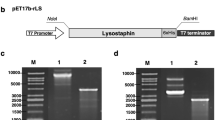Abstract
In vitro studies have demonstrated that bile salts have cytotoxic and bacteriostatic properties. The cytotoxic effect of bile salts is reduced when lecithin is added. The effect of lecithin on the bacteriostatic property of bile salts is not known. In this report, we test the hypotheses that (1) the bacteriostatic activity of bile salts is a function of the hydrophobicity of the molecules, and (2) lecithin, by engaging the hydrophobic component of bile salts, attenuates the bacteriostatic property of these molecules. Two common biliary pathogens,Escherichia coli andEnterococcus fecalis, were tested in this experiment. The results demonstrated that hydrophobic bile salts (sodium taurodeoxycholate, sodium deoxycholate) have more significant inhibition on the growth of bacteria when compared with the hydrophilic bile salts (sodium taurocholate, sodium chenodeoxycholate, and sodium tauroursodeoxycholate). When lecithin is added, creating a mixed micellar solution and mimicking thein vivo conditions, the antibacterial activities of even the more potent bacteriostatic bile salts are significantly reduced. The finding that lecithin significantly attenuates the bacteriostatic property of even the hydrophobic bile salts raises questions about the clinical significance of such bacteriostatic effectin vivo; as bile salts in the bile exist in mixed micellar solution.
Similar content being viewed by others
References
Cabral DJ, Small DM: Physical chemistry of bile.In Handbook of Physiology: Section 6 The Gastrointestinal System, vol III. SG Schultz (ed). American Physiological Society, Bethesda, Maryland, 1989, pp 621–662
Vlahcevic ZR, Heuman DM, Hylemon PB: Physiology and pathophysiology of enterohepatic circulation of bile acids.In Hepatology: A Textbook of Liver Disease; 2nd Ed. D Zakim, TD Boyer (eds). WB Saunders, Philadelphia, 1990, pp 341–377
Armstrong MC, Carey MC: The hydrophobic-hydrophilic balance of bile salts. Inverse correlation between reverse phase high pressure liquid chromatographic mobilities and micellar cholesterol-solubilizing capacities. J Lipid Res 23:70–80, 1982
Lindenbaum S, Rajagopalan N: Kinetics and thermodynamics of dissolution of lecithin by bile salts. Hepatology 23:70–80, 1984
Lowe PJ, Coleman R: Membrane fluidity and bile salt demage. Biochem Biophys Acta 640:55–65, 1981
Salvioli G, Mambrini A, Lugli R, Bertolani R, Zirilli E: Effect of different bile salts on erythrocyte membranes.In Recent Advances in Bile Acid Research. L Barbara, RH Dowling, AF Hofmann (eds). New York, Raven, 1985, pp 17–27
Coleman R: Bile salts and biliary lipids. Biochem Soc Trans 15:65S-80S, 1987
Floch MH, Gershengoren W, Diamond S, Hersh T: Cholic acid inhibition of intestinal bacteria. Am J Clin Nutr 23:8–10, 1970
Stewart L, Pellegrini CA, Way LW: Antibacterial activity of bile acids against common biliary tract organisms. Surg Forum 37:157–159, 1987
Hill MJ: Factor controlling the microflora of the health upper gastrointestinal tract.In Human Microbial Ecology. MJ Hill, PD Marsh (eds). Boca Raton, Florida, CRC Press, 1990, pp 57–86
Colemam R, Lowe PL, Billington D: Membrane lipid composition and susceptibility to bile salt demage. Biochim Biophys Acta 242:825–834, 1980
Fraser ME: The inhibitory effect of sodium deoxycholate onEscherichia coli. J Appl Bacteriol 34:765–771, 1971
Leifson E: New culture media based on sodium desoxycholate for the isolation of intestinal pathogens and for enumeration of colon bacilli in milk and water. J Pathol Bacteriol 40:581–586, 1953
Davies BD: Growth and death of bacteria.In Microbiology, 4th ed. BD Davies, R Dulbecco (eds). Philadelphia, JB Lippincott, 1990, pp 51–63
Velardi ALM, Groen AK, Oude Elferink RPJ, Van der Meer R, Palasciano F, Tytgat GNJ: Cell type-dependent effect of phospholipid and cholesterol on bile salt cytotoxicity. Gastroenterology 101:457–464, 1991
Sung JY, Costerton JW, Shaffer EA: The defense system in the biliary tract against bacterial infection. Dig Dis Sci 37:689–696, 1992
Author information
Authors and Affiliations
Rights and permissions
About this article
Cite this article
Sung, J.Y., Shaffer, E.A. & Costerton, J.W. Antibacterial activity of bile salts against common biliary pathogens. Digest Dis Sci 38, 2104–2112 (1993). https://doi.org/10.1007/BF01297092
Received:
Accepted:
Issue Date:
DOI: https://doi.org/10.1007/BF01297092




